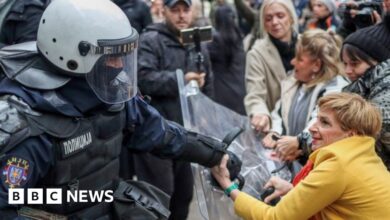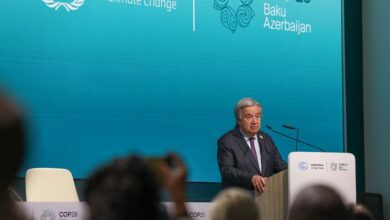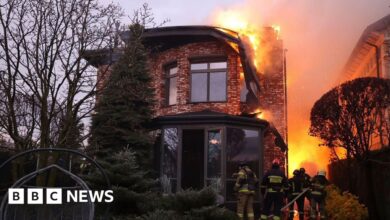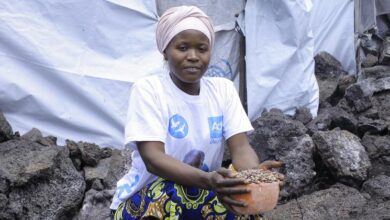The family’s pain because mother and child were burned to death in a tent in Gaza
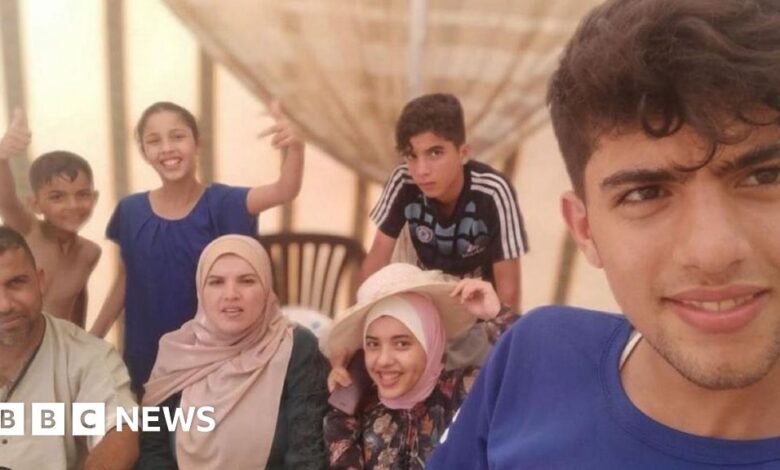
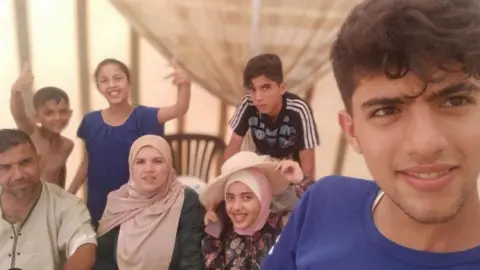 al-Dalou family photo
al-Dalou family photoWarning: This section contains graphic descriptions of death and injury
No conscience. There is no humanity. Only leaders stand by and watch without taking action.
This is what Ahmed al-Dalou believes, as images of his burning family replay in his mind. He said his life was gone. It died in the inferno of the al-Aqsa compound along with his sons and wife in the early hours of Monday, October 14.
In front of him was a shroud wrapped around the body of 12-year-old Abdulrahman, his youngest son.
The child’s pain lasted four days after the fire caused by the Israeli attack. The day before he passed away, Ahmed met him in the hospital and he was able to tell his father: “Don’t worry, I’m fine dad… I’m fine. Don’t be afraid.”
Ahmed half spoke, half cried as he talked about what was taken away from him.
“Three times I tried to pull him [Abdulrahman] out of the fire, but his body fell into it.”
His brother, Sha’aban, 19, and his mother, Alaa, 37, both died the night of the fire.
Sha’aban became the new symbol of Gaza’s terrible suffering. Images of him writhing in pain as he was burned to death in his family’s tent were shared around the world on social networks.
There were burns all over Ahmed’s face and hands. His voice rose, sounding harsh. Regarding the unnamed pilot who sent the missiles and the leaders who gave him orders, Ahmed said: “They broke my heart and my spirit… I wish the fire had consumed me.”
The strike occurred at around 01:15 local time last Monday (23:15 BST Sunday).
The Israeli military said it was targeting a Hamas “command and control” center in the al-Aqsa hospital complex in Deir al-Balah, central Gaza Strip.
Hamas denied operating in the hospital.

Four people were killed instantly and dozens more were injured, many of whom suffered severe burns. The Israel Defense Forces said they were “looking into the incident”.
A White House spokesman told CBS News, the BBC’s US partner, that footage of the fire was “deeply disturbing” and called on Israel to do more to protect civilians.
“Israel has a responsibility to do more to avoid civilian casualties – and what happened here is horrifying – even as Hamas is operating near the hospital in an attempt to use civilians as human shields .”
The US and other powers, including Britain, have expressed concern about civilian casualties since the early stages of the war.
 Reuters
ReutersPeople are burned to death, blown up and shot every day in this war.
Most of the death throes occur away from the camera. It was a frantic search for survivors in the rubble, dramatic scenes at the hospital, and endless funerals all recorded on camera.
But Sha’aban al-Dalou’s death was different. His hand could be seen, reaching out from the inferno, a figure enveloped in flames, writhing and unable to get any help.
Days after Sha’aban’s death, videos and photos of Sha’aban himself emerged. He is a typical teenager of his generation, aware of the power of social media and very adept at documenting his daily life.
The burning figure in the night of fire appeared to the world as a smart, articulate teenager, a software engineering student, a young man planning his family for a new life outside Gaza. He filmed himself donating blood and encouraged others to do the same.
“We have seen so many injuries, many children are in dire need of blood… All we ask for is a ceasefire and an end to this tragedy.”
We were only able to tell the story of the al-Dalou family thanks to our local journalist, who went to meet the survivors. International journalists from media organizations, including the BBC, are not granted independent access to Gaza by Israel.
In a video recorded in the tent where he died, Sha’aban describes how his family has been displaced five times since the war began a year ago. He has two older sisters and two younger brothers.
“We are living in very difficult circumstances,” he said. “We have to endure many different things such as homelessness, limited food and extremely limited medicine.”
In the background, as he spoke, there was the loud mechanical noise of Israeli observation drones, a constant in the daily and nightly sounds of Gaza.
Sha’aban and Abdulrahman’s surviving brother, Mohammed al-Dalou, told the BBC that he tried to rush into the fire to rescue his brother.
But the other wounded held him back, fearing he would also be killed. Mohammed did not sleep in his family’s tent but on the street, where he kept watch over their piled-up belongings.
“I called for help for someone to release me but to no avail… My brother’s leg was stuck and he couldn’t free himself. I think you saw it in the video. He’s raising his hand.
“That’s my brother. He is my support in this world.”
Sha’aban would come and wake him up for prayer in the morning with a bottle of water and he would tell him: “I will work for you.”
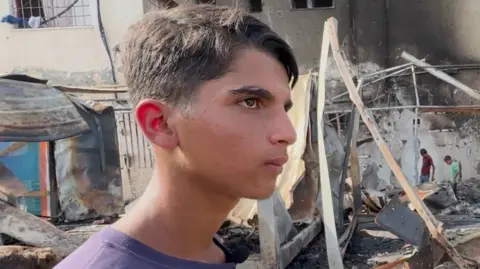
Mohammed recounted how the two brothers set up a stall at the hospital gate to sell food cooked by their family.
“We manage everything with our hard work. Everything we have is thanks to our efforts. We would have food and drink… then lose everything.”
He saw burned bodies but could only identify his mother. Even though her remains had been cut into pieces by fire, he still recognized a special bracelet.
“Without it, I wouldn’t know she was my mother. Her hand had left her body but the bracelet was still on it. I took it out of her hand.”
This is his only memento of the “kindhearted” woman in our house.
al-Dalou’s family was shocked. The survivors mourn the dead. Our BBC colleagues asked Mohammed about the psychological toll of watching loved ones die.
“I can’t describe it. I can’t describe how I feel. I want to explain to everyone but I can’t. I can’t describe it. I saw my brother burning in front of me and so did my mother.”
Then, as if asking a question on behalf of the deceased, he asked: “What more do you need than to remain silent? You saw us burning, and you kept quiet.”
Additional reporting by Haneen Abdeen and Alice Doyard


